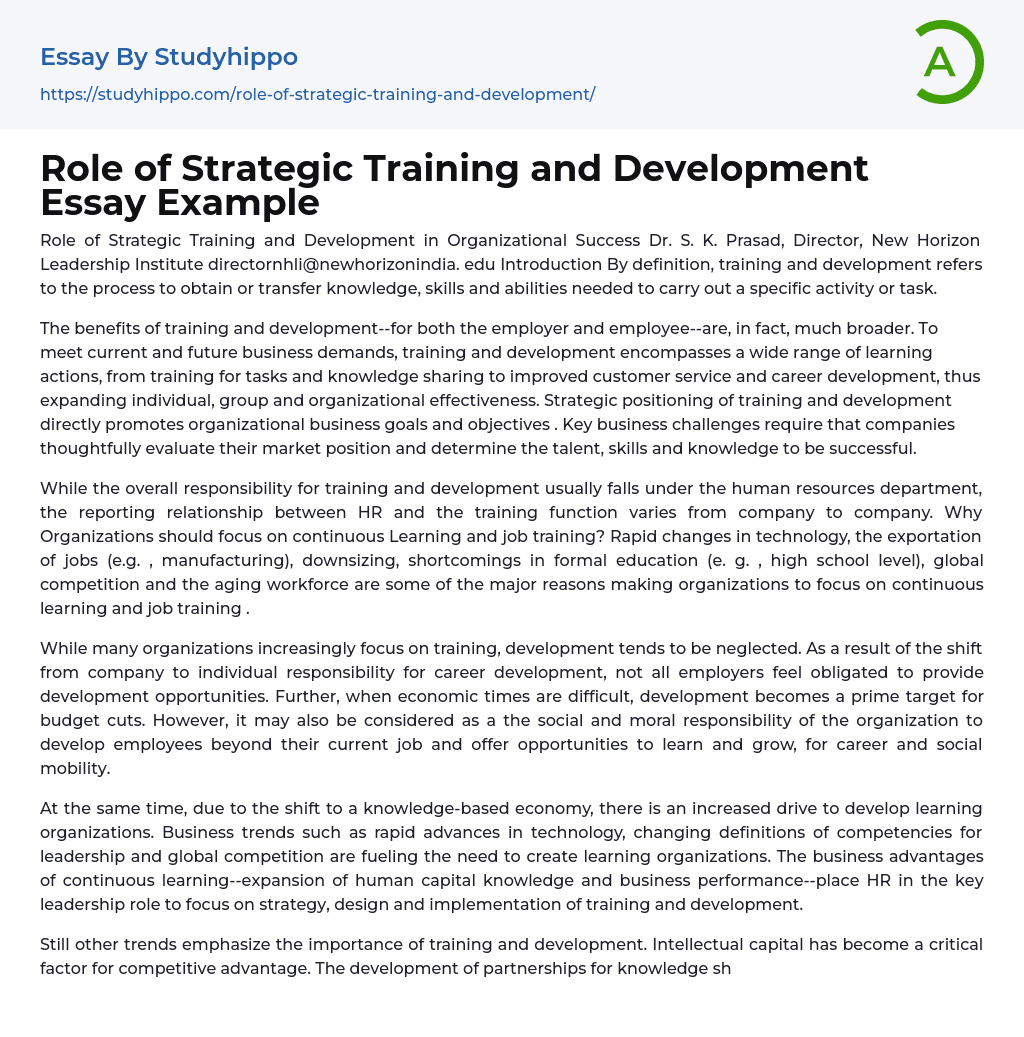Role of Strategic Training and Development in Organizational Success Dr. S. K. Prasad, Director, New Horizon Leadership Institute directornhli@newhorizonindia. edu Introduction By definition, training and development refers to the process to obtain or transfer knowledge, skills and abilities needed to carry out a specific activity or task.
The benefits of training and development--for both the employer and employee--are, in fact, much broader. To meet current and future business demands, training and development encompasses a wide range of learning actions, from training for tasks and knowledge sharing to improved customer service and career development, thus expanding individual, group and organizational effectiveness. Strategic positioning of training and development directly promotes organizational business goals and objectives . Key business challenges require that companies thoughtfully evaluate their market position and determine the talent, skills and knowledge to be success
...ful.
While the overall responsibility for training and development usually falls under the human resources department, the reporting relationship between HR and the training function varies from company to company. Why Organizations should focus on continuous Learning and job training? Rapid changes in technology, the exportation of jobs (e.g. , manufacturing), downsizing, shortcomings in formal education (e. g. , high school level), global competition and the aging workforce are some of the major reasons making organizations to focus on continuous learning and job training .
While many organizations increasingly focus on training, development tends to be neglected. As a result of the shift from company to individual responsibility for career development, not all employers feel obligated to provide development opportunities. Further, when economic times are difficult, development becomes a prime target for budget cuts. However, it may also be considered as a the
social and moral responsibility of the organization to develop employees beyond their current job and offer opportunities to learn and grow, for career and social mobility.
At the same time, due to the shift to a knowledge-based economy, there is an increased drive to develop learning organizations. Business trends such as rapid advances in technology, changing definitions of competencies for leadership and global competition are fueling the need to create learning organizations. The business advantages of continuous learning--expansion of human capital knowledge and business performance--place HR in the key leadership role to focus on strategy, design and implementation of training and development.
Still other trends emphasize the importance of training and development. Intellectual capital has become a critical factor for competitive advantage. The development of partnerships for knowledge sharing (e. g. , consultants and/or academic partners as subject matter experts in webinars) has increased.
To develop specialized programs, training departments have to work closely with academic partners to prepare high-potential employees for leadership roles. Further, competition due to globalization is a significant business challenge, thus bringing focus on the importance of global mindset.
These trends and business challenges have created the need for strategic approaches to training and development. HR's ability to align human capital resources with the business strategy and improve workforce skills through strategic training and development is paramount for organizational success.
Strategic Issues in Training and Development When strategically applied, continuous learning fosters knowledge and skills acquisition to help the organization achieve its goals. HR's role is to establish and implement a high-level roadmap for strategic training and development.
- Qualities essays
- Adaptation essays
- Adventure essays
- Adversity essays
- Aging essays
- Alcohol essays
- Barbie Doll essays
- Beauty essays
- Care essays
- Carpe diem essays
- Change essays
- Chess essays
- Chicken essays
- Choices essays
- Contrast essays
- Crops essays
- Development essays
- Dream essays
- Evil essays
- Experience essays
- Family essays
- Farm essays
- Fire essays
- First Love essays
- Focus essays
- Greed essays
- Hero essays
- Holiday essays
- House essays
- Housing essays
- Humility essays
- Humor essays
- Hypocrisy essays
- Integrity essays
- Law of Life essays
- Life Changing Experience essays
- Life Experience essays
- Lifestyle essays
- Limitations essays
- Love Story essays
- Mother Tongue essays
- Motherhood essays
- My Neighborhood essays
- Myself essays
- Mystery essays
- Narcissism essays
- Never Give Up essays
- Nursing essays
- Object essays
- Opportunity essays




